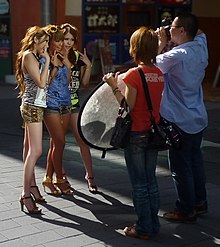Gyaru
This article needs additional citations for verification. (January 2009) |

Gyaru (ギャル) is a Japanese transliteration of the English word gal, that of girl being gaaru (ガール). The name originated from a 1970s brand of jeans called "gals", with the advertising slogan: "I can't live without men", and was applied to fashion- and peer-conscious girls in their teens and early twenties. Its usage peaked in the 1980s and has gradually declined. The term gradually drifted to apply to a younger group, whose seeming lack of interest in work or marriage gained the word a "childish" image. It is now used almost interchangeably with kogyaru.
Gyaru subculture is still a large influence in Japan's fashion economy with gyaru brands branching out and becoming more accessible in rural areas. In Tokyo, more often than not, a shopping center at each main train station dedicated to offering the newest and trendiest items from popular Gal brands. Some brands are also reaching overseas by having their items easily accessible in webshops offering world-wide shipping services. Gal Circles (gyaru-sa/ギャルサー) are also a fun part of a gal's life. After peaking in 2007, the gyaru trend appears to have declined in Japan, but has gained in popularity in China.[1]
A Gal Circle is a group of gals that meet up and hold events promoting gal style, music, and parapara dancing. There are two main types of Gal Circles, Nago-cir (comfort circles) and Ive-cir (event circles).
What is gyaru?
Gyaru fashion is a type of Japanese street fashion that originated in the 1970’s. [citation needed]. Gyaru is most commonly referred to as ganguro, but it is actually a subculture of gyaru. was popular in the 1990’s, but shortly died out in the early 2000's. Gyaru is a girly-glam style, breaking away from traditional standards of beauty. Dwelling on the man-made (wigs, fake eyelashes, fake nails, etc). Gyaru fashion neither fit well with the Japanese traditional culture nor how the media portray ideals of Japanese women. It is often classified as a sign of youth rebellion.
Gyaru fashion is typically characterized by having heavily bleached or dyed hair (mostly shades from dark brown to blonde), excessively decorated nails, and dramatic makeup.
The makeup typically consists of dark eyeliner, fake eyelashes and cosmetic circle lenses so as to create the illusion of large, anime-like eyes. Extremist tend to get vivid color hair wigs, for example, neon pink or lime green.
Clothing pieces for gyaru fashion differ depending on which gyaru style the individual chooses.
Subcategories of gyaru
There are various subcategories of "gals" depending on the choice of fashion, and also gender.
- Bibinba (ビビンバ): This look usually includes a lot of gold, and jewelry. Similar to b-gal.
- Banba (バンバ): Banba is a lighter form of manba. Banbas wear less white makeup than manbas; they also use more glitter, and doesn't have neon colored hair as much. Banbas wear more extreme-looking types of false eyelashes, and colored contact lenses. Banbas wear darker colors than manbas, and sometimes dress in club wear. The most respected banba Gal-cir is Angeleek; there are 22 members in the Tokyo group, and they have many other groups throughout the Japan.
- Ganguro (ガングロギャル): A gyaru with an artificial deep tan and bleached hair. This style was popular in the late 1990s, and early 2000s.
- Gyaruo (ギャル男): A male gyaru.
- Kogyaru: Generally a high school student (高校生 kōkōsei).
- Yamanba: Like manba, but the nose stripe goes past the eyebrows.
Related media
Gyaru Clothing/Accessories Brands
Notable Japanese Gyaru brands:
Notable non-Japanese Gyaru brands:
Gyaru cosmetic brands
Favored brands that gyarus use.
Magazines
Music
Music genres favored in the gyaru scene
See also
- Gyaru-moji, a type of lettering used in mobile phone messages by gals
- Gyaru-oh, the male equivocation to gyaru
- Kogal, sub-genre of gyaru
Notes
- ^ Janette, Misha, "Where have all the gyaru gone?", Japan Times, 14 October 2011, p. 18.
